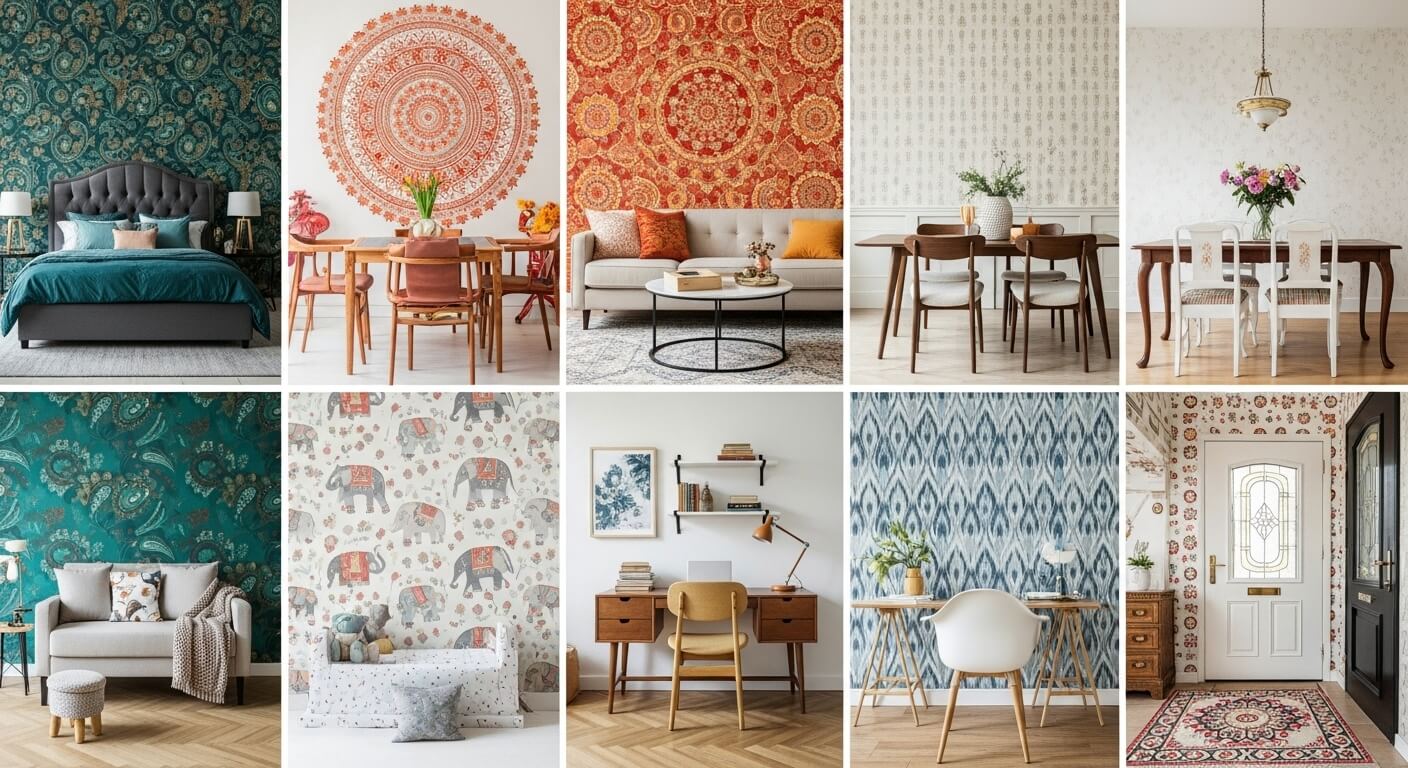Which Rooms Suit Indian Pattern Wallpaper

Indian motifs bring history, color, and a sense of movement to everyday spaces. If you want a fast update with no paste or mess, explore indian peel and stick wallpaper.
Living and dining areas
These are social zones, so go bold if you like. A large block print or a mandala-inspired repeat turns one wall into a focal point behind a sofa or a dining table. Use rich colors like indigo, saffron, emerald, and terracotta. They warm up an open-plan room. They also create zones without extra furniture. If your space already has patterned textiles, choose a simpler jaali lattice or fine paisley so the look stays balanced. Add brass, carved wood, or rattan for texture and a grounded, global style.
Bedrooms and nurseries
Sleep spaces need comfort first. Pick lighter tones and smaller repeats. A floral Indian print works beautifully on the headboard wall because it frames the bed like a tapestry. For a softer feel, the airy Indian pattern floral Wallpaper adds gentle blooms and stays calm even in small rooms. For a nursery, soft pastels with loose vines or tiny motifs feel playful but not loud during nap time. Keep the rest of the room quieter — plain bedding, a solid rug, and minimal clutter — so the pattern can breathe.
Entryways, halls, and stairs
Short on square footage? That’s perfect. Pattern adds instant character where furniture won’t fit. Use a narrow stripe with Indian accents in a hallway to lead the eye forward. On stair risers, a peel-and-stick panel brings color without a full renovation. Choose durable, wipeable finishes for these high-traffic areas. Patterns with mid-tone backgrounds hide scuffs better than pure white.
Interesting:
Home office and creative corners
Your video calls need a background that looks sharp but not busy. A neat block print or a tone-on-tone motif does the job. It frames your face and cuts visual noise. If you share the office with a living area, an accent wall helps the zone read as “work” even when the desk is small. Add a linen curtain, a plant, and a slim lamp to finish the frame.
Kitchens and bathrooms: use care, choose the spot
Water and heat matter. Keep panels away from direct steam, splashes, and cooktop heat. A breakfast nook, a pantry wall, or the side of an island are safer bets than a sink backsplash. In baths, a powder room is ideal because humidity swings are lower and you can ventilate quickly. Look for a smooth, cleanable surface and always test a sample first on your paint. Good adhesion starts with dry, cured paint and a dust-free wall.
Great places for Indian patterns (at a glance)
- Living room: behind the sofa, around a media console, or on built-ins for a boutique feel.
- Dining room: full-wall treatment to set the mood; candlesticks and wood chairs keep it classic.
Bedroom: headboard wall with a calm palette; add cotton throws and a jute rug for texture. - Nursery or kids’ room: small florals or playful paisley; pair with low storage and soft lighting.
- Entry and hallway: statement print for instant character; durable finish for easy wipe-downs.
- Home office: camera-friendly repeat that reads clean on video; limit colors to two or three.
- Powder room: dramatic pattern plus a simple mirror; good ventilation keeps it fresh.
How to choose and use the look
- Match scale to room size. Big repeats suit wide walls; tiny prints flatter compact spaces.
- Edit your palette. Pull two main colors from the print, then repeat them in textiles and art.
- Start with one wall. If you crave more later, add adjacent panels to wrap the corner.
- Mind the light. North-facing rooms often love warmer tones; bright rooms handle deep shades well.
- Sample first. Check color shift morning to night and confirm the adhesive suits your paint.
- Prep matters. Clean, dry, and smooth walls help panels lie flat and align neatly.
- Think maintenance. Choose wipeable finishes for entries and play zones; use gentle cleaners.
- Renting. Peel-and-stick panels remove more cleanly than pasted options and let you change looks fast.
Smart ways to start
Begin with one area you see every day: behind the sofa, the headboard wall, or an entry niche. Keep the palette tight, repeat key colors in textiles, and layer a few natural textures. You’ll get a space that feels personal, balanced, and easy to live in — without a full remodel.